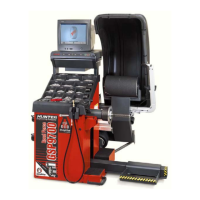24 3. Mounting Wheels on the Balancer GSP9700 Series Road Force Measurement System Operation
Mounting Error Detection Features
To verify that the tire/wheel assembly is centering, remount the tire/wheel assembly
and observe the results. Do any of the following conditions occur?
Weight amount varies excessively
Weight location changes
Runout and road force measurements vary excessively
If any of these conditions occur, the centering accuracy of the tire/wheel assembly
needs to be verified.
There are two methods using wheel runout that the GSP9700 will utilize to detect
mounting error:
Anytime the wheel runout is measured, the displayed diagnostic
message may caution the operator to check wheel mounting if
runout on inner and outer bead seats move up and down or side
to side together.
From the balance screen, the operator can choose to perform a
CenteringCheck
®
. The CenteringCheck
®
feature will automatically
confirm if the wheel is centered for the operator on the balancer
(preventing improper measurement from occurring).
See page 30, CenteringCheck
®
, for a detailed description of the feature.
Front/Back Cone Mounting
Cone mounting is one of the most common and reliable ways to mount wheels on
balancers. Select the proper wheel mounting cone by placing it in the center bore of
the wheel to be balanced. Select the cone that contacts the wheel nearest the center
of the cone.
Place the wheel mounting cone on the spindle against the spring plate. Mount the
wheel with the inner rim facing the balancer and centered on the cone.
Install the clamping cup and wing nut on the spindle shaft against the wheel and
secure the entire assembly by firmly tightening the wing nut, while depressing the
foot pedal to hold the spindle in place.

